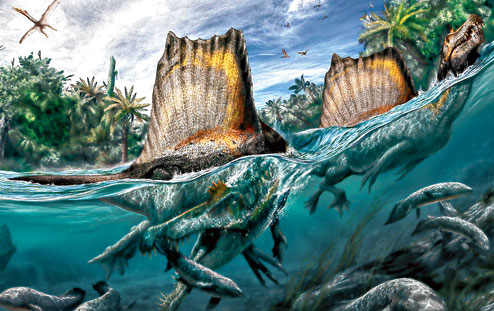 |
| Cretaceous Leviathan: The only known dinosaur adapted to life in water, Spinosaurus swam the rivers of North Africa a hundred million years ago. The massive predator lived in a region mostly devoid of large, terrestrial plant-eaters, subsisting mainly on huge fish. This illustration will appear in the October issue of the National Geographic magazine. Art: Davide Bonadonna Sources: Nizar Ibrahim, University of Chicago; Cristiano Dal Sasso and Simone Maganuco, Natural History Museum of Milan |
Sept. 11: A partial skeleton found over six years ago in Morocco’s Sahara desert region has now been labelled the first known semi-aquatic dinosaur, a giant predator that was larger than the Tyrannosaurus rex and spent most of its time swimming in water.
An international team of palaeontologists that studied the fossilised skeleton from 97 million years ago has called it the first dinosaur known to have adapted to water, a creature that may change existing ideas about these extinct reptiles.
A research paper describing the dinosaur will appear in the US journal Science on Friday.
“This is a creature like no other dinosaur we’ve seen before,” Nizar Ibrahim, a palaeontologist at the University of Chicago and lead author of the paper, told The Telegraph over the phone. “The adaptation for swimming is written all over its skeleton.”
The researchers said the dinosaur, named Spinosaurus aegyptiacus, appeared to have had dense bones tailored for buoyancy in water, webbed feet for paddling, a long neck and trunk that helped movement in water and small nostrils in the middle of the skull that would have allowed it to breathe while a part of its head was in water. Its conical teeth were suited to catch fish.
“Its long and slender jaw was somewhat similar to what we find on modern-day ghariyals in India,” Ibrahim said. “This shape can open and shut rapidly under water -- this feature along with the shape of the teeth would be very useful to hunt in water.”
The fossils indicate that the Spinosaurus was the largest predatory dinosaur to roam the Earth, measuring more than nine feet longer than even the largest Tyrannosaurus rex specimen, the National Geographic Society and the University of Chicago said in a joint media release today. The findings will feature in the October National Geographic magazine’s cover story, the release said.
The world’s palaeontology community has waited a century to make sense of the Spinosaurus.
German palaeontologist Ernst Stromer had in 1911 first described bizarre-shaped backbones and a long and slender jaw in fossils he had found in the Egyptian part of the Sahara desert.
While Stromer named the fossil Spinosaurus, or spine reptile, and documented his findings in notebooks, the fossils themselves were destroyed during World War II when a Royal Air Force raid razed the Munich museum where they had been kept.
Since then, palaeontologists had been looking for more remains of the creature.
Ibrahim, who says he was inspired by Stromer’s work to explore the Sahara, first saw the new bones during a field visit to Morocco in 2008. They had been found earlier by a nomadic fossil hunter in Erfoud, an oasis town at the edge of the Sahara.
Palaeontologists now had a partial skeleton with a skull, a backbone, a hipbone, thighbones, a foot and a tailbone, among other fossil fragments.
“What surprised us even more than the dinosaur’s size were its unusual proportions,” Paul Sereno, head of the University of Chicago’s Fossil Lab, said in the media release. “We see limb proportions like these in early whales, not predatory dinosaurs.”
Sereno and Ibrahim, collaborating with scientists in Italy, Morocco and Britain, analysed the bones, compared them with the original drawings in Stromer’s notes, and digitally reconstructed a model of the creature.
Scientists believe the Sahara desert 97 million years ago was a river system that stretched from present-day Morocco to Egypt. “It was teeming with life, including sharks, fish, flying reptiles, and predatory dinosaurs,” Ibrahim said.
The National Geographic Society said a life-size skeletal replica would be the centrepiece of a new exhibition at the National Geographic Museum in Washington DC. Titled “Spinosaurus: Lost Giant of the Cretaceous”, it will run from September 12 this year to April 12 next year.
The creature will also be the topic of a National Geographic/NOVA special that will air on November 5 on PBS, a US television channel.
Team members have predicted that the findings would provide new insights into the diversity of dinosaurs.
“In the past two decades, several finds have demonstrated that certain dinosaurs gave origin to birds,” said Christiano Dal Sasso, curator of vertebrate palaeontology at the Museum of Natural History, Milan, Italy.
“The Spinosaurus represents an equally bizarre evolutionary process, showing that some predatory dinosaurs adapted to semi-aquatic life and invaded river systems in Cretaceous North Africa.”










